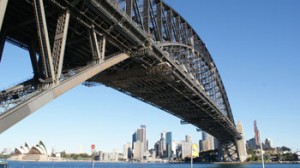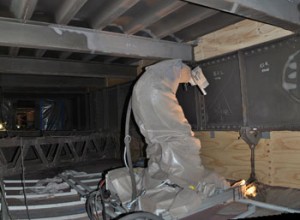Robots clean the Sydney Harbor bridge
 Using the Sydney Harbor Bridge as an example, Australian specialists have highlighted how service robots will soon revolutionize how steel structures are serviced. The robust lightweight robotic systems are planned to go into serial production at the end of 2014. At their core is a lightweight arm designed by SCHUNK, the competence leader for clamping technology and gripping systems.
Using the Sydney Harbor Bridge as an example, Australian specialists have highlighted how service robots will soon revolutionize how steel structures are serviced. The robust lightweight robotic systems are planned to go into serial production at the end of 2014. At their core is a lightweight arm designed by SCHUNK, the competence leader for clamping technology and gripping systems.
The idea of automating the cleaning of steel structures was born in Sydney about seven years ago, under the direction of Professor Dikai Liu, with the development of an automated sandblasting robot for servicing steel bridges. Today, SABRE Autonomous Solutions is responsible for pre-commercial implementation.
After a successful testing stage, the sandblasting robot has become part of the standard equipment used by the maintenance team of the world-famous Sydney Harbor Bridge. With a span of 503 meters, an arch crown height of 134 meters and 52,800 tons of steel, it is one of the heaviest and longest steel arch bridges in the world. As with any steel bridge, the Sydney Harbor Bridge must be continuously maintained and protected against corrosion. This includes sandblasting and repainting 485,000m2 of steel, or about 68 football fields. A single coat requires about 30,000 liters of paint.
Rosie and Sandy, the two blasting robots, confidently and tirelessly blast dirt, rust and old paint from the steel girders. While some of the workers have to take a break every 15-30 minutes due to the extreme physical strain, the two powerful robots blast their way through meter after meter without interruption – much more persistently, quickly and precisely than a human ever could. The robots take about 50 minutes to complete a segment. Using a Kinect sensor and special algorithms, a mapping system calculates the sandblaster’s exact path, preventing collisions. The operators, in turn, monitor the sandblasting process from a safe distance.
Since the two service robots have been in operation, the safety, cost effectiveness and quality of the sandblasting work has risen markedly, confirms Greg Peters, Engineering Design Manager at SABRE Autonomous Solutions. “Due to the fatigue while sandblasting, even experienced workers are unable to achieve such consistent results”, said Peters. The lightweight robot is manually positioned on a simple rail system. It then automatically scans the steel structure, generating a three-dimensional map. The work begins once the operator initiates the sandblasting process by remote.
Mobile lightweight arm that can take a pounding
The core of both sandblasting robots is a LWA 4 lightweight arm with very high load capacity designed by SCHUNK. Secured under a protective cover, the lightweight arms remain unaffected by rust, dust and humidity, as well as the vibrations and shifting stresses of sandblasting. To change location, the robot can either move along the tracks to another location on-site, or be dismantled into compact units and taken away by hand. The unique combination of mobility, robustness, power and lightweight construction make the LWA a multi-functional helper in service robotics. A consistently high repeat accuracy of ±0.1 mm provides optimal conditions for precise operations. The lightweight robot is both portable and mobile. It can carry a maximum load of 15kg.
 Its modular design allows the number of degrees of freedom, drive power, and type and length of spacers and joints to be freely defined. Since the boosters and drive control system are directly embedded in the lightweight arm, the system does not require a separate control cabinet. Instead, the entire control and regulator electronics are integrated into the joint drives. Position, speed and torque can be regulated flexibly. Integrated intelligence, universal communication interfaces, and data transmission and power supply cable technology allow the lightweight arm to be integrated quickly and easily into existing control concepts. It can also be controlled by embedded PCs. The individual modules can also be easily controlled using the CAN interface that comes standard in all LWAs, with optional speed or power control. The lightweight arm is particularly energy efficient due to its lightweight, highly rigid design, which pays dividends in mobile applications in the form of long runtimes.
Its modular design allows the number of degrees of freedom, drive power, and type and length of spacers and joints to be freely defined. Since the boosters and drive control system are directly embedded in the lightweight arm, the system does not require a separate control cabinet. Instead, the entire control and regulator electronics are integrated into the joint drives. Position, speed and torque can be regulated flexibly. Integrated intelligence, universal communication interfaces, and data transmission and power supply cable technology allow the lightweight arm to be integrated quickly and easily into existing control concepts. It can also be controlled by embedded PCs. The individual modules can also be easily controlled using the CAN interface that comes standard in all LWAs, with optional speed or power control. The lightweight arm is particularly energy efficient due to its lightweight, highly rigid design, which pays dividends in mobile applications in the form of long runtimes.
Whereas before, sandblasting required teams of up to three workers as well as significant safety precautions, on the Sydney Harbor Bridge, one operator controls and monitors up to two robots. Hazardous, physically straining and, at times, even harmful routine tasks are almost entirely performed by robots. Once a robot finishes a segment, a worker takes the blaster gun and sees to the more complicated detail work. The payback period for the robot system is around two years. SABRE is currently developing another mobile sandblasting robot in addition to those used for bridges, weighing a maximum of 65kg and that can be easily transported and used for numerous other applications. The central element of this new robot is also an LWA lightweight arm by SCHUNK.
The LWA by SCHUNK is simply unbeatable in its weight class. Its weight-to-load capacity ratio is unparalleled. Industrial robots may be less expensive, but they are way too heavy. They require more effort and huge controls and are usually connected to a 380V cable. The SCHUNK lightweight arm has simple controls, can be controlled remotely, driven by a simple 24V DC generator and is so light that two people can move it several times throughout an entire day. Compared to other lightweight arms, it’s also far more robust.
The system will come on the market in Australia in October 2014. The United States and Europe will follow at the start of 2015. A few more things have to be standardized by then. Our goal is to make the robot as compact and light as possible. We also hope to integrate a remote maintenance option in the future.
Visit the Schunk website for further information.















